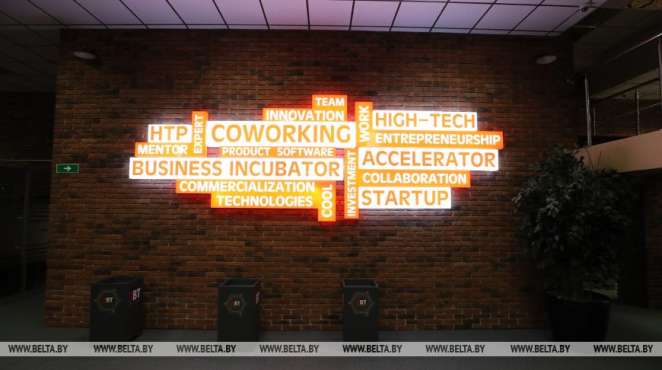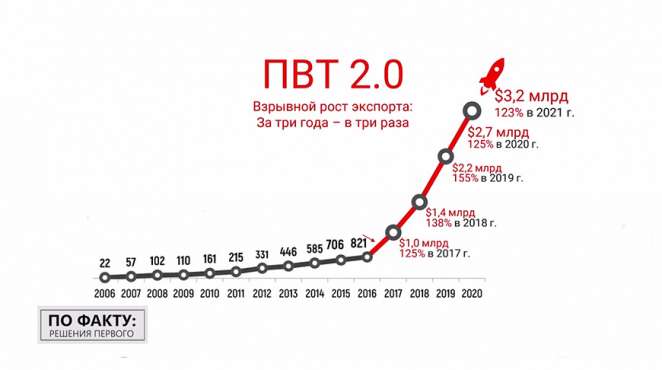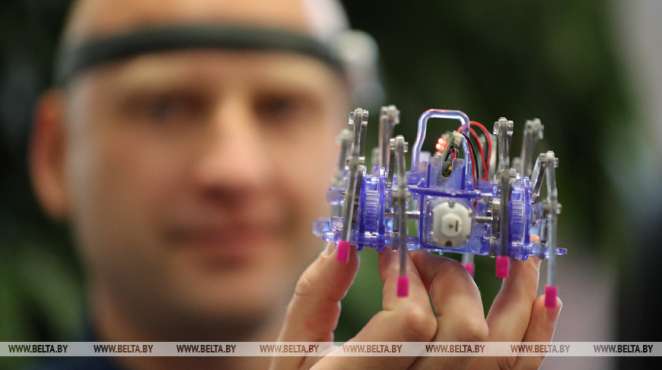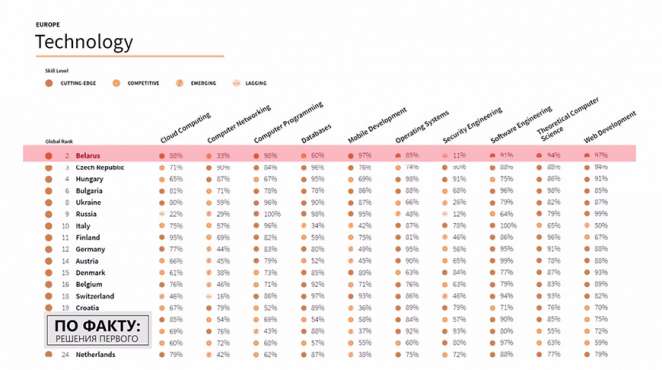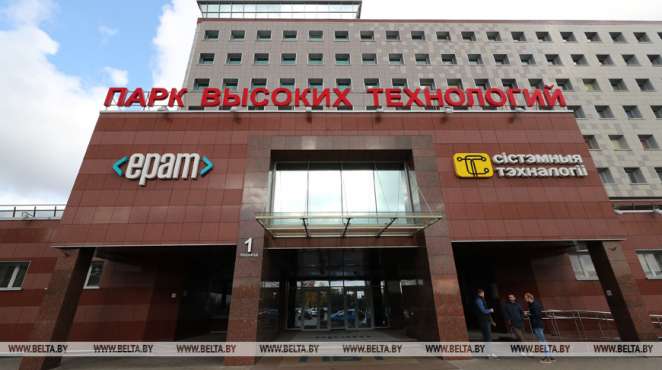What future awaits Belarusian IT industry? Lukashenko's latest statements about Hi-Tech Park
9 January 2023, 15:06
In late 2017 Belarus President Aleksandr Lukashenko signed the Digital Economy Development Ordinance, thanks to which the Belarusian IT industry was granted unprecedented conditions for development and the Hi-Tech Park, which was established back in 2005, became famous all over the world. “Belarus is turning into a Silicon Valley. It is becoming a world center for software development.” This is what The Wall Street Journal and Forbes wrote about the country. “A paradise for programmers.” “Exceptional potential and a far-sighted economic policy,” this is how Eric Gundersen, the founder of the American startup Mapbox, and the former U.S. Secretary of State Michael Pompeo evaluated capabilities of the republic.
In the new episode of BelTA's YouTube project After the Fact: Lukashenko's Decisions we will tell you how Belarus became an IT country, will dispel myths about the Hi-Tech Park, and will try to find out what future awaits the Belarusian IT industry after all.
How did the Hi-Tech Park come to be?
Let's start from afar. In the early 2000s Belarusian authorities decided to encourage the development of information technologies. For a reason. First, they believed that it would help increase the competitiveness of the economy. Second, it was necessary to stop the brain drain. And not just to stop, but to also attract the best of the best to the country. The authorities decided to implement ambitious plans by creating their own Silicon Valley.
“I've been recently hearing from some scientists, especially young ones, that Belarus does not have conditions for the development and application of brains, that all the conditions are available abroad while Belarus has nothing. As the head of state, I cannot but be alarmed by such views. Therefore, a decision was made to create a high-tech park in Belarus where all conditions for the creativity of scientists will be enabled. We have to keep the best minds in Belarus so that they do not go abroad. We have to return those who left to work abroad, attract those programmers who are working today ‘in the kitchen' as well as specialists from neighboring countries,” Aleksandr Lukashenko noted at a seminar for executive personnel in Vitebsk in 2004.
At the same time the president stressed that the Hi-Tech Park should bring economic benefits to the country and people instead of being created only for the sake of a pretty picture.
Work on the project went on for many months. The authorities decided not to fuss and not make hasty decisions in order to avoid mistakes. And on 22 September 2005 Aleksandr Lukashenko signed an ordinance on the creation of the Hi-Tech Park. HTP resident companies received preferences that were unprecedented for that time. First of all, discounts on income tax and contributions to the Social Security Fund. In June 2006 the first four residents registered with the Hi-Tech Park. Over one year software development and software export increased by several times. IT companies started coming out of the shadows, registering with the HTP and paying exclusively official salaries to employees. They were given an incentive to develop and investors were given an incentive to invest.
Why was the Digital Economy Development Ordinance needed?
And everything seemed to be going well. Software export grew by tens of millions of U.S. dollars every year. The president was informed about “fantastic accomplishments.” But the pace of development of the Belarusian analogue of the Silicon Valley did not satisfy him yet. Belarusian IT specialists mainly focused on outsourcing their services and fulfilling orders for foreign companies. They received only a small share of the profits compared to the benefits from the product-oriented business model and the commercialization of the final product. Obviously, this was not what the Belarusian authorities originally intended to achieve.
Active discussions about the development of digital economy started in Belarus in 2017. Aleksandr Lukashenko hosted a conference in late 2017 to discuss the draft of the relevant ordinance.
“The domestic IT sphere needs to be given a new impetus for development so that talented people can fully realize their capabilities here. Belarus should become a real center of attraction for talented people, successful companies and international corporations. Our country has every chance of becoming at least a regional leader in the development of the most advanced areas – artificial intelligence, big data, blockchain technology,” the head of state said.
The Digital Economy Development Ordinance was signed several days later. It was a monumental event not only for the Hi-Tech Park but for the global industry. This decision produced a truly international response. Elements of the English law began to apply to Hi-Tech Park residents. The procedure for hiring qualified foreign workers was simplified. Belarus was the first country to legalize a number of technologies. For example, smart contracts. Work with blockchain technologies was legalized and the free hiring of foreign specialists was allowed. HTP residents now had an opportunity to conclude foreign trade transactions electronically. The document produced an effect almost immediately. The Hi-Tech Park and its residents entered a period of explosive growth.
“IT professionals should be credited for this accomplishment. The question was whether we will have it or we won't. They approached this responsibly. The IT professionals themselves. And today they work thanks to the decisions that were made. Therefore, no one should think of themselves as a great person, that they did something great. The IT professionals did it and I am grateful to them for acting decently," Aleksandr Lukashenko said a couple of years later.
How did the ordinance affect the Belarusian IT industry?
In 2018-2021 the number of companies joining the Hi-Tech Park exceeded the figure registered in the previous 12 years by five times. The number of product companies skyrocketed by 14 times. The volume of export did not simply increase, it was tripled over the period of three years: from $1 billion in 2017 to $3.2 billion in 2021. Since 2014 and until the adoption of the new ordinance, the growth rate declined every year.
But the most important thing is that after the adoption of the new ordinance sales of goods and services on the domestic market of Belarus increased by many times. Before 2017 these indicators were nearly disregarded. The previous management of the Hi-Tech Park apparently did not consider it important to pay any attention to this. In 2017 Hi-Tech Park resident companies sold goods and services worth Br190 million on the domestic market. One year later this figure increased by more than Br100 million. And in 2021 the volume of sales of IT products and services on the domestic market amounted to Br1.3 billion. Substantial growth, right?
At present Hi-Tech Park resident companies use three business models. Order-based model or outsourcing is when a company develops software to order and transfers the product to the customer along with all the rights to it. Development centers or outstaffing is when a company has a single foreign founder and the founder is also the only client. Product model is when a company creates and develops its own product, has the full rights to it and earns money by scaling it. It can be, for example, some kind of software, a game, or a mobile app.
The Belarusian Hi-Tech Park has become the leading IT cluster in the region. Export of computer services per capita amounted to $320 in 2021. For comparison, it was $266 in neighboring Poland, $155 in the USA, $56 in India
How did Belarus' approaches to education change?
All these achievements are largely due to the high level of IT education in Belarus. The Hi-Tech Park is actively involved in creating a unique continuous training system for the industry: from kindergarten to university. HTP residents have created and maintain almost a hundred joint research and production laboratories on the basis of universities. Specialized educational courses have been developed and are being offered in appropriate university departments. At the same time, more than 40 branches of university departments have been opened directly on the premises of HTP resident companies and in the park.
For more than five years the nationwide educational project “Programming - the second literacy” has been implemented in schools. And today more than 80,000 Belarusian schoolchildren study the basics of programming in extracurricular classes from the second grade.
If everything is clear with schools and universities, then what kind of programming can be taught in kindergartens? Of course, it's not about operating a computer. The educational project "Computer science without a socket" was launched in Belarus in 2020. Its main goal is to form algorithmic skills and logical thinking in children 5-7 years old. Specifically for them the Hi-Tech Park has developed a unique methodology that allows identifying inclinations in children and developing the basics of algorithmic thinking and logic in a playful way.
Natalya Karlyukevich, Deputy Head of the Education Department of the Hi-Tech Park Administration, said that a special diagnostic procedure had been worked out in order to check the effectiveness of the program. An experiment was staged in kindergartens in 2021-2022. It turned out that the kids, who had been participating in the hobby group, scored 2.5 times more points in all the areas of development of logical thinking, cognitive ability, and cognition interest in comparison to the kids, who had not participated in the project.
Natalya Karlyukevich noted: “We have developed two more projects. The kids are studying robot technology as part of the project Robot Algorithms. And we have science for kids as part of the project Invention Lab. It is a pilot project for now. The kids are studying physics basics. We've launched Robot Algorithms in kindergartens this year. Since it is a young project, we don't use many kindergartens. And we are now actively starting to promote these two projects.”
Belarus is still in the top of the online educational platform Coursera. In the 2022 Global Skills Report Belarus continues to rank first among 33 states in Europe in the Technology category. In the world ranking, as in the previous two years, Belarus retains the second position while Indonesia is in the lead.
Today Russia officially seeks to catch up and overtake Belarus in the development of the information technology industry. In 2021 the Russian government adopted a roadmap hoping to increase the appeal of its jurisdiction in comparison with the world market leaders, which includes Belarus.
What preferences does the Hi-Tech Park enjoy and how much do HTP residents pay in taxes?
There is a myth that the Belarusian IT industry made a leap forward thanks to unprecedented tax benefits. They say that if any company is granted such terms, it would show similar results. Let's figure it out. What tax preferences did Belarusian IT specialists get? VAT, income tax, offshore tax - 0%. Tax on income of foreign organizations - 0%. VAT and income tax on cryptocurrency mining, operations with cryptocurrency and tokens - 0%. Income tax - 9% (the rate was set at 13% in 2021-2022 as part of the measures to combat the COVID-19 pandemic). Contributions to the Social Security Fund are calculated on the basis of country's average salary. It is approximately 7%. Deductions to the administration of the Hi-Tech Park - 1% of the turnover.
Sounds really very tempting. But. Despite the benefits Hi-Tech Park residents pay more taxes to the budget than all enterprises of the Industry Ministry and the Agriculture and Food Ministry. More than any other industry burdened with taxes. The real tax burden on HTP residents is higher than the average tax burden on enterprises in the economy. Every Hi-Tech Park worker pays four times more income tax than the average worker in the economy.
Why did it happen? Everything is simple. In the IT business more than 80% of the prime cost is salaries which are subject to income tax. On average, in the economy more than 60% of the cost is made up of material costs that are not taxed. And those who believe that the billions of U.S. dollars earned by Belarusian IT specialists leave the country and go to accounts of Western or Eastern shareholders are wrong. Almost all of this money remains in Belarus in the form of salaries to employees. And those, in turn, spend it by purchasing goods and services within the country.
Today the digital products of the High-Tech Park residents are known throughout the world. Belarusian companies work with world giants. Applications and software of Belarusian developers are used by billions of people. In terms of production and export of software products, the country has long been among the world leaders.
What is happening to the Belarusian IT industry now?
Why has Aleksandr Lukashenko criticized IT people so often lately and why did some companies decide to leave Belarus? A presidential election took place in Belarus in 2020. Aleksandr Lukashenko won it in a landslide victory. But even before the vote in Belarus, protests began to be instigated from abroad. Among the “supporters of change” were representatives of the IT industry. True, as it turned out later, only a few percent of those working in this industry took to the streets to protest. And these few percent, in turn, amounted to only a couple of percent of the total number of protesters. But they were so often mentioned by the media that the effect was impressive.
It could not but hurt Aleksandr Lukashenko, thanks to whom the Hi-Tech Park was set up in the country and the Belarusian IT industry became known to the whole world.
“I confess that neither I nor the security agencies paid proper attention to this. We simply brushed it off. I thought: well, it is impossible for my own children to start a war against me. So we paid the cost. It turns out that such children can indeed fight against their parents if the children are well paid. I mean, our people, it must also be frankly admitted, who work in the Hi-Tech Park, receive decent incomes, decent salaries in comparison to the country's average, preferred big money and carried out commands of their foreign masters. Overseas ones most often,” the head of state said as he heard out a report on the development of the Hi-Tech Park recently. “Therefore, allowances must be made for the fact that they were still controlled. And since these are mostly young people, and the management of the Hi-Tech Park did not work too hard over there, it didn't know its people and didn't counteract all these negative trends in time - we got what we got.”
In 2020-2022 news began to appear about various IT companies leaving Belarus. It started happening against the backdrop of street protests and the enforcement of sanctions against Belarus. Is there any political undertone to this? No. The main customers of Belarusian companies are abroad. All they need is to receive their product on time, to carry out a financial transaction without hindrance. Foreign owners and shareholders also have no time for politics. The main thing for them is the value of shares and profit. And when protests happened in Belarus followed by sanctions against the country, many companies had to relocate their business. Or rather, they were forced to relocate by customers and owners. It is unlikely that they followed the course of the presidential election in Belarus, but they definitely followed the movement of money in their accounts.
Hi-Tech Park Deputy Director Kirill Zalessky noted; “Relocation per se (in other words, the movement of IT specialists between offices of one corporation in different countries) has always been a thing. It existed prior to 2022 and prior to 2020. It is actually one of the forms of doing the job. A programmer goes to where the project is, to where the programmer is supposed to be for a certain period of time. Respectively once the project is finished, the programmer moves on. These processes have always existed. Nobody simply paid them any attention. Now we see a totally clear trend that despite all the forced relocations of our programmers out of our country most of them are coming back to the motherland at the drop of a hat. They have their own home here, decent standards of living, education, healthcare, and so on.”
What awaits Belarusian IT professionals in the future?
After these events and ambiguous statements by the president some mass media starting burying the Hi-Tech Park. But in November 2022 Aleksandr Lukashenko held a meeting with the administration of the Hi-Tech Park and the government and heard out a report on the park's development prospects. The head of state said that it is necessary to look into the future so that both programmers and companies could work and develop in peace. In other words, the authorities turned the page.
Kirill Zalessky stressed: “The past year has not been simple for the park. Naturally the geopolitical situation around our borders and the overall world crisis in the IT industry have had an effect. You've heard the news about mass staff layoffs virtually in all the global IT corporations at the end of last year. Respectively it was a world trend that had a certain effect on us, too.”
Nevertheless, the IT industry demonstrated rather good financial results in 2022, the Hi-Tech Park administration said. There is no statistics for the entire year yet. In January-September 2022 export totaled $2 billion. The Hi-Tech Park deputy director said: “These figures were positively received by the head of state. This year we will continue developing the Hi-Tech Park, looking for new markets, solidifying our positions on existing markets, working inside the country, and developing the product model. In other words, in all these areas and on all the main tasks that we have to accomplish.”
Kirill Zalessky continued: “As for work on Belarus' domestic market, we tightly cooperate with the Communications and Informatization Ministry, which acts as the main regulator of economy digitization matters. The park acts more like a contractor in this regard. In other words, our companies will take an active part in the projects, which are starting inside the country. As for foreign operations, our legal regime has been enhanced. It means bigger opportunities for our resident companies.”
The world knows Belarus due to many things. Including the IT industry. The Hi-Tech Park administration promises that there will be a lot of good news ahead. The Hi-Tech Park created by the president's decision has been and will remain the pride of the country.
